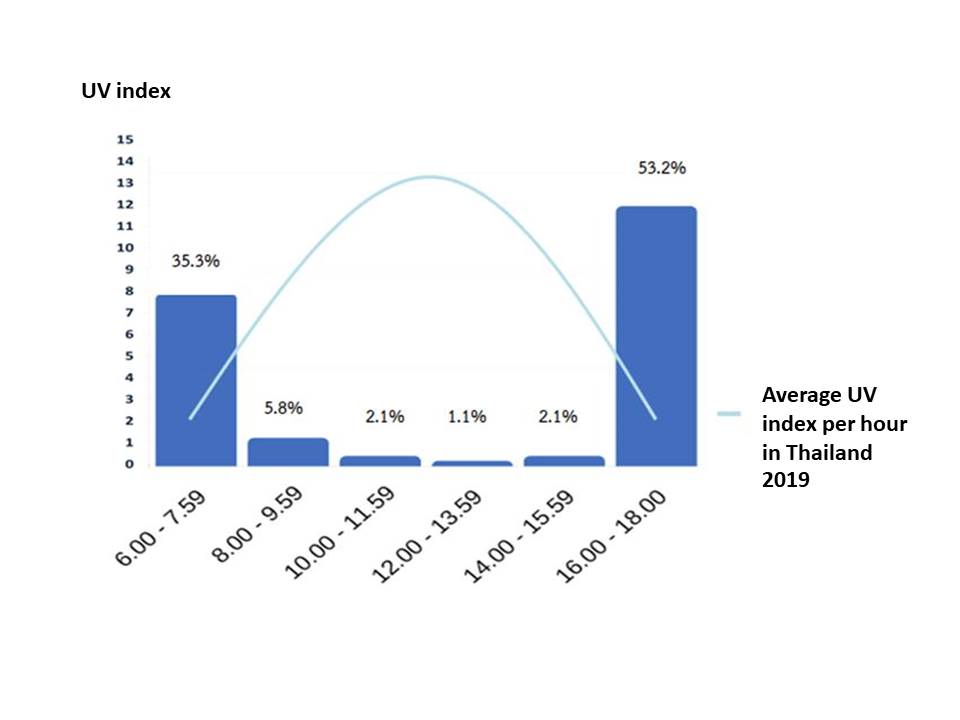Sun Protective Behaviors in Daytime Outdoor Runners in Thailand
Keywords:
Daytime outdoor runners, sun protective behaviors, sunscreenAbstract
Background: Outdoor running has become popular in Thailand. However, performing outdoor activities during the daytime potentially introduces risk of harmful sun ray exposure.
Objectives: To explore the characteristics of daytime running activities and sun protective behaviors, including the demographic data of daytime runners, running behaviors, sun protective methods, reasons for not taking sun protective measures, and factors influencing the use of sun protective materials.
Materials and Methods: An online, questionnaire-based descriptive study was conducted from 1-31 May 2020 with Thai outdoor runners aged 18 years or older who had performed outdoor activities from 6 A.M. - 6 P.M. at least once during the previous year.
Results: Of all 316 completed questionnaires, 106 (33.54%) were male, 197 (62.34%) were female and 13 (4.11%) were lesbian, gay, bisexual, transgender, or queer (LGBTQs). The average age was 36±9.68 years. The average BMI was 22.62±3.53 Kg/m2. The 44 (13.92%) participants used sunscreen only, whereas 83 (26.26%) participants used various types of sun protective equipment only. Factors that promoted sunscreen application were female (p<0.001), LGBTQs (p=0.001), and lower BMI (p=0.004). The factor that promoted the use of sun protective equipment was older age (p=0.02).
Conclusion: Less than half of all the Thai outdoor runners took proper sun protective precautions. Some participants never used sun protective materials. Therefore, Thai outdoor runners should be encouraged to increase sun protective behavior by being provided information regarding the harmful effects of sunlight.
References
McDaniel D, Farris, Valacchi G. Atmospheric skin aging-Contributors and inhibitors. J Cosmet Dermatol 2018;17:124-37.
Elsner P, Hölzle E, Diepgen T, et al. Recommendation: daily sun protection in the prevention of chronic UV-induced skin damage. J Dtsch Dermatol Ges 2007;5:166-73.
Amano S. Characterization and mechanisms of photo ageing-related changes in skin damages of basement membrane and dermal structures. Exp Dermatol 2016;3:9-14.
Chung JH. Photoaging in Asians. Photodermatol Photoimmunol Photomed 2003;19:109-21.
Little MP, Linet MS, Kimlin MG, et al. Cumulative solar ultraviolet radiation exposure and basal cell carcinoma of the skin in a nationwide US cohort using satellite and ground-based measures. Environmental Health 2019;18:114.
Lavker RM, Gerberick GF, Veres D, Irwin CJ, Kaidbey KH. Cumulative effects from repeated exposures to suberythemal doses of UVB and UVA in human skin. J Am Acad Dermatol 1995;32:53-62.
Mitchell DL, Volkmer B, Breitbart EW, Byrom M, Lowery MG, Greinert R. Identification of a non-dividing subpopulation of mouse and human epidermal cells exhibiting high levels of persistent ultraviolet photodamage. J Invest Dermatol 2001;117:590-5.
Lucas RM, Neale RE, Madronich S, McKenzie RL. Are current guidelines for sun protection optimal for health? Exploring the evidence. Photochem Photobiol Sci 2018;17:1956-63.
Carter OB, Donovan RJ. Public (Mis)understanding of the UV Index. J Health Commun 2007;12:41-52.
Richtig E, Ambros-Rudolph CM, Trapp M, et al. Melanoma markers in marathon runners: increase with sun exposure and physical strain. Dermatology 2008;217:38-44.
Moehrle M. Outdoor sports and skin cancer. Clin Dermatol 2008;26:12-5.
Jinna S, Adams BB. Ultraviolet radiation and the athlete: risk, sun safety, and barriers to implementation of protective strategies. Sports Med 2013;43:531-7.
World Health Organization [internet]. INTERSUN: The global UV project: a guide and compendium. 2013; [cited 2020 March 8]. Available from: https://apps.who.int/iris/bitstream/handle/10665/42814/9241591056.pdf?sequence=1
Young AR, Claveau J, Rossi AB. Ultraviolet radiation and the skin: Photobiology and sunscreen photoprotection. Journal of the American Academy of Dermatology 2017;76:S100–9.
Duarte AF, Nagore E, Silva JNM, Picoto A, Pereira AC, Correia OJC. Sun protection behaviour and skin cancer literacy among outdoor runners. Eur J Dermatol 2018;28:803-8.
Dermatological Society of Thailand [Internet] Clinical Practice Guideline for Sunscreen 2010; [cited 2020 March 8] Available from http://www.dst.or.th/files_news/Sunscreen_Usage_2010.pdf
Stechschulte SA, Kirsner RS, Federman DG. Sunscreens for non-dermatologists: what you should know when counseling patients. Postgrad Med 2011;123:160-7.
Olsen CM, Thompson BS, Green AC, Neale RE, Whiteman DC; QSkin Sun and Health Study Group. Sun Protection and Skin Examination Practices in a Setting of High Ambient Solar Radiation: A Population-Based Cohort Study. JAMA Dermatol 2015;151:982-90.
Robinson JK. Sun Safety. JAMA Dermatol 2018;154:380.
Holman DM, Berkowitz Z, Guy GP Jr, Hawkins NA, Saraiya M, Watson M. Patterns of sunscreen use on the face and other exposed skin among US adults. J Am Acad Dermatol 2015;73:83-92.
Lawler S, McDermott L, O'Riordan D, et al. Relationships of sun-protection habit strength with sunscreen use during outdoor sport and physical activity. Int J Environ Res Public Health 2012;9:916-23.
Ellis RM, Mohr MR, Indika SH, Salkey KS. Sunscreen use in student athletes: a survey study. J Am Acad Dermatol 2012;67:159-60.
Falk M, Anderson CD. Influence of age, gender, educational level and self-estimation of skin type on sun exposure habits and readiness to increase sun protection. Cancer Epidemiol 2013;37:127–32.
Stanton WR, Janda M, Baade PD, Anderson P. Primary prevention of skin cancer: a review of sun protection in Australia and internationally. Health Promot Int 2004;19:369-78.
Silva ESD, Dumith SC. Non-use of sunscreen among adults and the elderly in southern Brazil. An Bras Dermatol 2019;94:567-3.
Christoph S, Cazzaniga S, Hunger RE, et al. Ultraviolet radiation protection and skin cancer awareness in recreational athletes: a survey among participants in a running event. Swiss Med Wkly 2016;146:w14297.

Downloads
Published
How to Cite
Issue
Section
License
เนื้อหาและข้อมูลในบทความที่ลงตีพิมพ์ในวารสารโรคผิวหนัง ถือเป็นข้อคิดเห็นและความรับผิดชอบของผู้เขียนบทความโดยตรงซึ่งกองบรรณาธิการวารสาร ไม่จำเป็นต้องเห็นด้วย หรือร่วมรับผิดชอบใดๆ
บทความ ข้อมูล เนื้อหา รูปภาพ ฯลฯ ที่ได้รับการตีพิมพ์ในวารสารโรคผิวหนัง ถือเป็นลิขสิทธิ์ของวารสารฯ หากบุคคลหรือหน่วยงานใดต้องการนำทั้งหมดหรือส่วนหนึ่งส่วนใดไปเผยแพร่ต่อหรือเพื่อกระทำการใดๆ จะต้องได้รับอนุญาตเป็นลายลักอักษรจากบรรณาธิการวารสารโรคผิวหนังก่อนเท่านั้น


